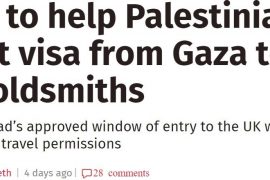You don’t need to be a politically partisan Israeli to understand the significance of a speech given by MK Isaac (Bougie) Herzog, party chairman of the centre-left Zionist Union, on Wednesday.
The opposition leader said:
“I don’t see a possibility at the moment of implementing the two-state solution…I want to yearn for it, I want to move toward it, I want negotiations, I sign on to it and I am obligated to it, but I don’t see the possibility of doing it right now.”
Herzog explained that, if he became prime minister, he’d implement practical security measures – such as completing the security barrier around all the settlement blocs and physically separating the Palestinian villages surrounding Jerusalem from the capital – rather than pursuing a bilateral peace agreement.
Herzog’s speech of course merely acknowledged what’s understood about Oslo and its aftermath by the vast majority of Israelis within the broad centre: That the Palestinians have demonstrated they’re unprepared to accept a final agreement which ends the conflict and closes all historical claims against the Jewish state; and that, in the current environment, and absent security arrangements that the Palestinians will likely not agree to, the new country of Palestine would likely quickly become a failed state, or devolve to something akin to the Hamas terror entity in Gaza. Additionally, the bloody consequences of withdrawals from Gaza and South Lebanon indicate to most that, contrary to conventional wisdom, terror isn’t about ‘the occupation’, but about the continued rejection of Israel’s right to exist within any borders.
Enter the Guardian and its recent love letter to Haaretz (To Whom it May Concern review – searing images of Israel by Haaretz, Jason Farago, Jan. 20).
The second paragraph of what is ostensibly a museum review of an exhibit of Haaretz photos is a perfect illustration of how the Guardian – and, to varying degrees, other UK media outlets – sees Haaretz and how this colors their understanding of the Israeli electorate.
The photograph, shot by Nir Kafri, appeared in the Israeli newspaper Haaretz in 2001, and it forms the opening salvo of To Whom It May Concern, an insistent, eye-opening exhibition in New York of photojournalism from one of the world’s most important newspapers. Haaretz is Israel’s oldest daily, just shy of a hundred years old. “It is the very model of a liberal newspaper,” the Guardian affirmed in 2014 – a bastion of seriousness, scepticism and oppositionality in a country with little time for nuance. Its detractors, inevitably in a region of such angry divisions, decry the paper as far-left or even anti-Israel, but in fact it espouses a disappearing sort of Zionism, one intertwined with liberal values and freedom for all. In a lengthy 2011 profile, the New Yorker editor David Remnick called Haaretz “arguably the most important liberal institution” in Israel. But as the country continued its drift to the right, and as oppositions between Israelis and Palestinians hardened further, Haaretz has grown lonelier – and thus even more vital.
In short, the Guardian sees Haaretz how journalists and editors at the paper see themselves: the surviving remnant of what’s left of “true Zionism”, stalwart defenders of Israel’s (eroding or even disappearing) democracy and moral decency amidst a dangerous extreme-right drift. “A better Israel”, the Guardian informs us later in the review, “is what Haaretz has been advocating all these years”.
Indeed, the photographic examples cited by the article evoke the paradigm of Israeli villainy contrasted with Palestinian victimhood which is almost entirely devoid of nuance – a binary moral tale told in one form or the other in the news and opinion sections of the Guardian (and other British dailies), whose reporters rely on Haaretz to understand the Jewish state.
Of course, one of the main problems with viewing Israel and its people through the Haaretz prism is that, except for the English foreign edition, Haaretz is an extremely marginal publication, read by a small number of actual Israelis – garnering a 6.1% market share within the national print media according to research in 2013.
Whilst the paper may remain popular with the cultural and political elite, it’s gradual drift ideologically to embrace the delegitimizing – and at times even antisemitic – radical left, coupled with an increased propensity towards errors, mischaracterizations, falsehoods and mistranslations renders it increasingly irrelevant to a decidedly news-obsessed Israeli society.
Contrary to the Haaretz narrative, most Israelis don’t question the strength and durability of their democracy, and in fact take immeasurable pride in its democratic institutions, the independence of its press and judiciary and commitment to civil rights. Moreover, most Israelis understand that “end the occupation” is merely a slogan, not a serious policy proposal to deal with extraordinarily difficult political and security issues.
As Times of Israel senior analyst Haviv Retig Gur summed up the significance of Herzog’s speech on Twitter, “Herzog tries to be taken seriously by a skeptical public by redefining ‘left’ as an aspiration rather than a policy”.
Perhaps Israelis and their supporters abroad would have more respect for Haaretz and the Guardian if they didn’t seem to possess such contempt for the hard-earned skepticism and undeniable sobriety of the overwhelming majority of Israelis who – like Bougie Herzog – long passionately for peace, but see the world and the region as it is, not as they’d like it to be.
Related articles
- Haaretz: Lost in Translation (CAMERA)





